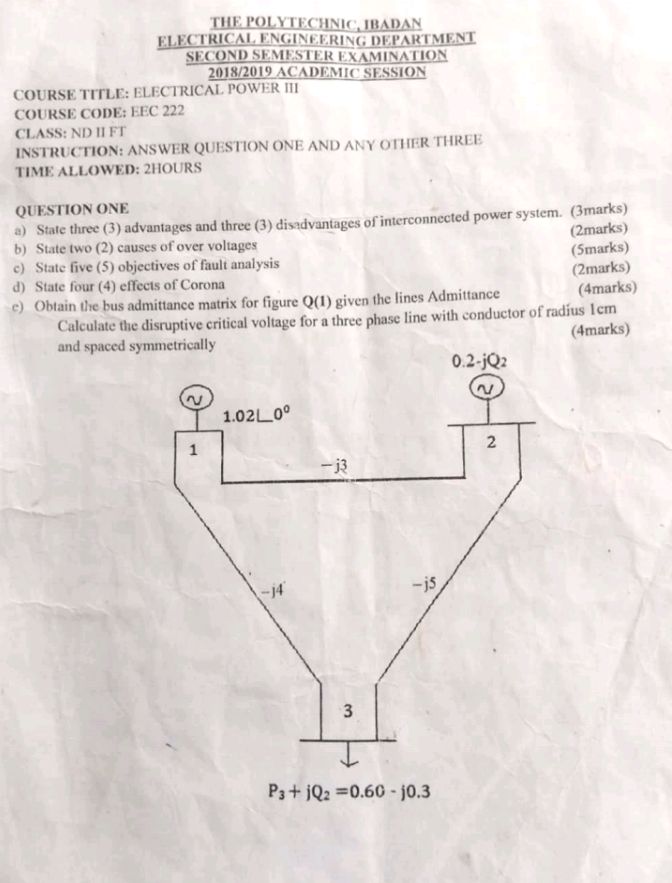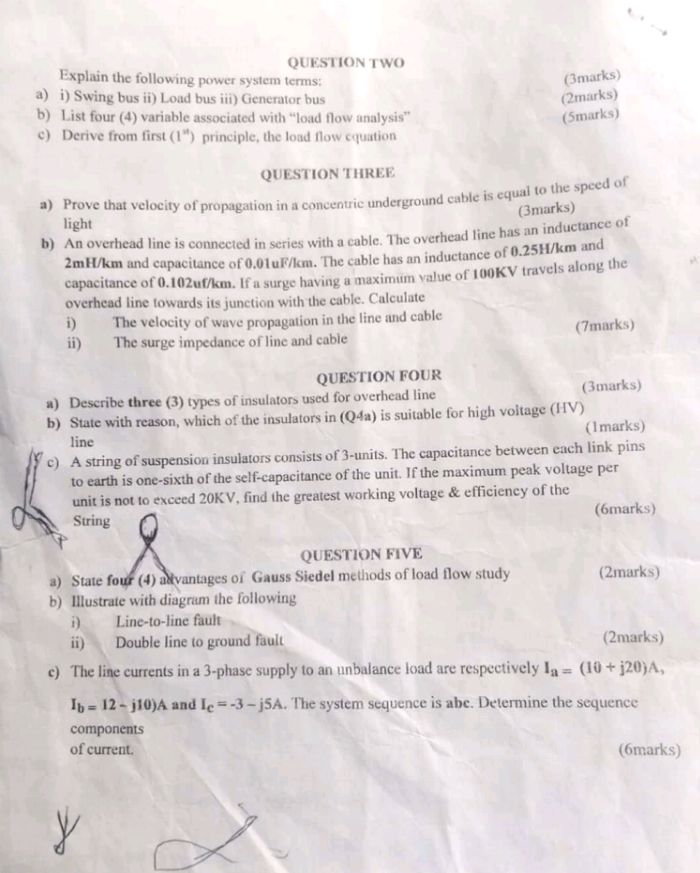Course title: electrical power III
Course code: EEC 222
Class: ND2 full time
Instruction: Answer question one and any other three
Time allowed: 2 hours

QUESTION ONE (1)
a) state three (3) advantages and three (3) disadvantages of interconnected power system. (3 marks)
ADVANTAGES
- Increase reliability of supply
- Ensures economical operation
- Exchange of peak load
DISADVANTAGES
- It requires more investment for load control centre and automatic control
- It requires more automation, high reliability and security of each point
- Technical problems of large interconnected power system regarding planning, operation and control are more complex
B) state two(2) causes of over voltages. (2 marks)
I) Lightning discharge
II) Switching
III) Faulty or damaged electrical wiring
C. State five(5) objectives of fault analysis
- To determine the minimum and maximum short circuit current
- To investigate the operation of protective relay
- To determine the rated rupturing capacity breaker
- To determine the fault current distribution and bar voltage level during fault condition
- To determine unsymmetrical fault current single and double line to line fault and sometimes for general fault current.
D) state four (4) effect of corona
II. Power less in lines
III. Corrosion due to coronal formation
IV. Damage to insulator used in high voltage
V. Harmonic current flow resulting from coronal formation
E) Obtain the bus admittance matrix for figure Q(1) given the lines admittance. Calculate the disruptive critical voltage for a three phase line with conductor of radius 1cm and spaced symmetrically, 4m apart

QUESTION TWO (2)
A) Explain the following power system terms
I. Swing bus. II. Load bus. III. Generator bus
II. Load bus: At the load bus, the quantity specified are the real and reactive power. The requirements during flow analysis are the voltage magnitude and the phase angle.
III. Generator/voltage controlled bus: At this bus the voltage magnitude corresponding to the generator voltage, the real power and the quantities required during load flow analysis are the reactive power and phase angle power.
B) List four (4) variables associated with load flow analysis
II. Phase angle
III. Real power
IV. Reactive power
V. Per unit reactance
C) Derive from first(1st) principle, the load flow equation
QUESTION THREE (3)
Prove that velocity of propagation in a concentric underground cable is equal to the speed of light
B) An overhead line is connected in series with a cable. The overhead line has an inductance of 2mH/km and capacitance of 0.01ûF/km. The cable has an inductance of 0.25H/km and capacitance of 0.102ûF/km. If a surge having a maximum value of 100kv travels along the overhead line towards its junction with the cable. Calculate
I) The velocity of wave propagation in the line and cable
II) The surge impedance of line and cable
QUESTION FOUR (4)
A) Describe three (3) types of insulators used for overhead line
I. Pin type insulator: are made in piece up to 25kv and above that voltage range in more than one piece. They’re used for up to 50kv only. Each piece represent 25kv to increase the voltage, you’ve to add another piece making it 50kv, it’s therefore uneconomical for use
II. Suspension type insulator: are made in form of disc and a number of them is used in a flexible string for the voltage range desires with the conductor being attached to the lower end for 400kv lines, 19 disc of overall length 3.84cm are used.
III. Strain type insulator: are obtained after a string of suspension insulator is used in an horizontal position. They’re mainly used in line terminals and cross road.
B) State with reason, which of the insulator in (Q4a) is suitable for high voltage (HV) lines
Strain type insulator because they’re used for line terminals and transmission lines
C) A string of suspension insulators consists of 3-units. The capacitance between each link pins to earth is one-sixth of the self-capacitance of the unit. If the maximum peak voltage per unit is not to exceed 20kv, find the greatest working voltage and efficiency of the string.
QUESTION FIVE(5)
A) State four (4) advantages of Gauss Siedal methods of load flow study
I. It requires less computer memory
II. It is easy to program
III. Requires less time per iteration
IV. It works well when programmed using rectangular coordinate.
B) Illustrate with diagram the following
I) line to line fault
II) Double line to ground fault
C) The line current in a 3-phase supply to an unbalance load are respectively Ia = (10 + j20)A, Ib = (12- j10)A and Ic = (-3 – j5)A. The system sequence is abc. Determine the sequence components of current.
QUESTION SIX (6)
A) Define load flow study
Load flow analysis (study) is also known as power flow analysis. It’s the computation of voltage and phase angle at each bus in a power system under balance 3ø steady condition in the process. The real power and the reactive power flow in equipment such as transmission line and transformer as well as equipment losses are completed.
B) State four (4) reason for load flow study
I. To estimate the system capacity
II. To determine the optimum system buses
III. To determine the voltage magnitude, phase angle, real and reactive power at each buses in a power system.
IV. To determine the operation of a system under existing condition and in future expansion
The author is a distinction student of the Polytechnic Ibadan. If you wish to know more about him or this subject and many more related content, privately chat him up on WhatsApp using 07025056477


Pingback: Prove that velocity of propagation in a concentric underground cable is equal to the speed of light • Emperorelectricalworks